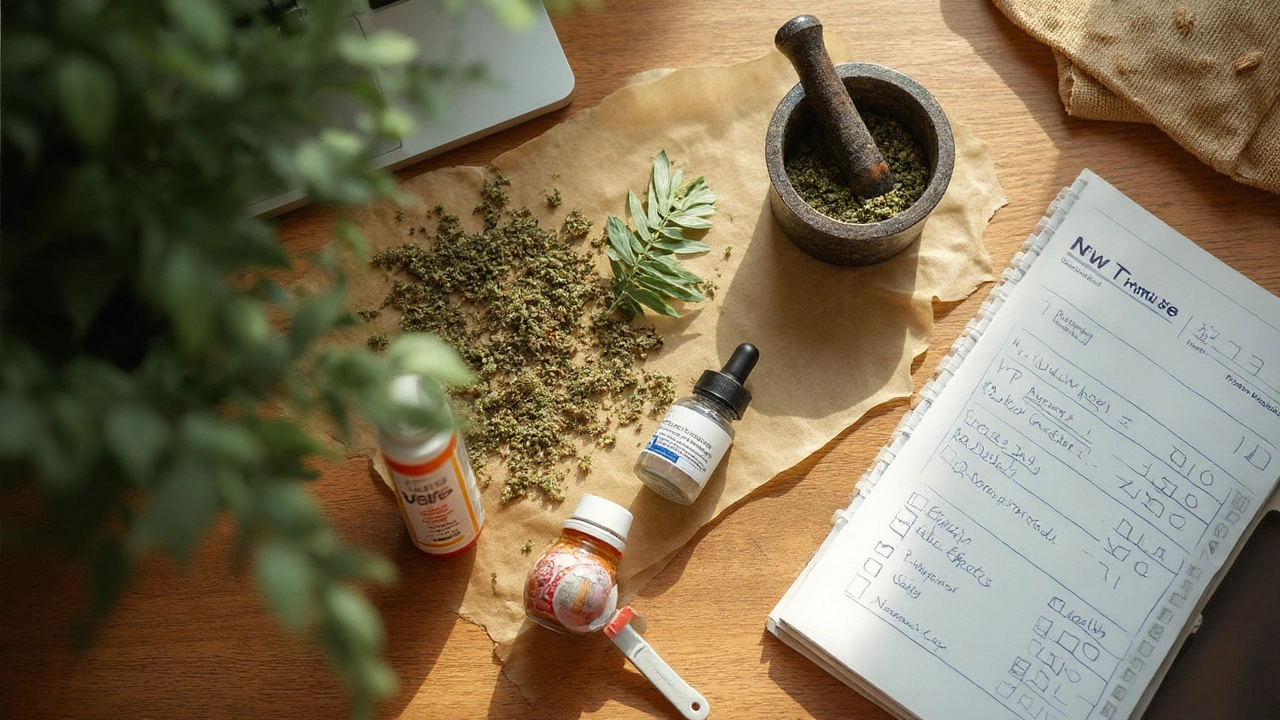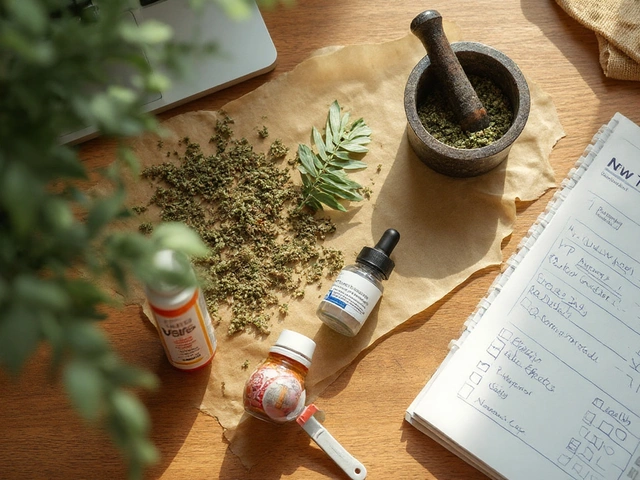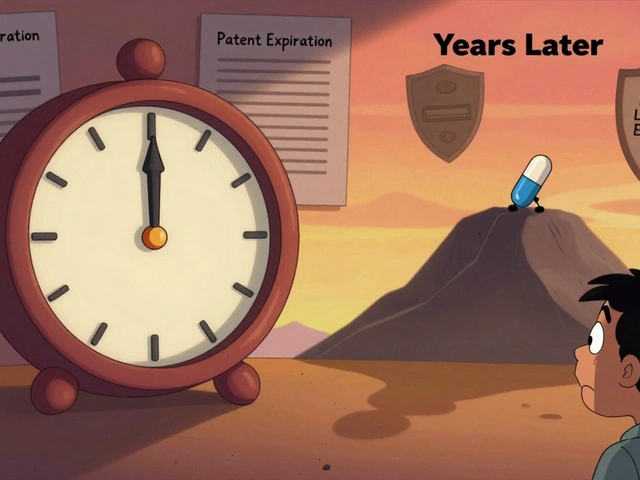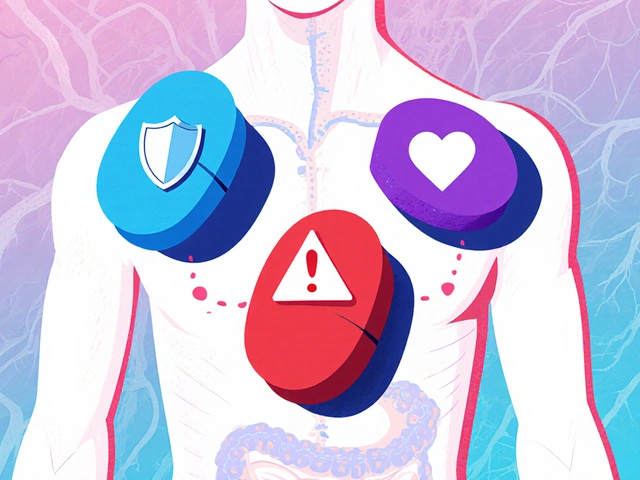Big promises sell capsules. But does Jaborandi actually work, and is it safe to take every day? Here’s the straight talk: Jaborandi contains pilocarpine, a strong plant alkaloid that increases saliva and sweat. It’s a real drug in eye drops and tablets, not a gentle tea. The pull is obvious-hair regrowth claims, help for dry mouth, natural appeal-but the science is mixed, and safety matters more than marketing. Expect clear evidence, simple guidance, and honest trade-offs here.
- TL;DR: Jaborandi comes from Pilocarpus leaves. Its main compound, pilocarpine, is a prescription medicine in many countries. Supplements vary widely and can be risky if dosed wrong.
- Best-supported use: pilocarpine (the drug) can help dry mouth and glaucoma-under doctor care. Evidence for hair growth from oral Jaborandi is weak.
- Key risks: sweating, drooling, cramps, slow heart rate, wheeze. Dangerous if you have asthma, certain heart issues, ulcers, or are on specific meds.
- New Zealand note: pilocarpine is a prescription medicine here. Importing a potent Jaborandi product can land you in a legal and safety grey zone.
- Better plan: match your goal (hair loss, dry mouth, eye pressure) to proven options and talk to your GP or pharmacist before you try Jaborandi.
What Jaborandi Is, and What It Can and Can’t Do
Let’s set the stage. Jaborandi is a common name for Pilocarpus species, a shrub native to Brazil. The leaves hold pilocarpine, a muscarinic agonist. Translation: it nudges your parasympathetic system, which ramps up secretions and squeezes smooth muscle. That means more saliva and sweat, smaller pupils, slower heart rate-and side effects if you overshoot.
Medicines from Jaborandi aren’t new. Pilocarpine eye drops have been used for glaucoma for decades. In 2021, the U.S. FDA cleared low-dose pilocarpine eye drops for presbyopia (age-related near vision). Pilocarpine tablets have long been prescribed for dry mouth in people after head-and-neck radiation or with Sjögren’s syndrome. Those are regulated, doctor-prescribed products with precise dosing.
Supplements are a different story. Some capsules and tinctures sold as “Jaborandi” or “Pilocarpus leaf” claim benefits for hair, scalp, sweating balance, digestion, or even weight loss. The problem? Leaf strength and pilocarpine content swing a lot by species, harvest, and processing. Labels often don’t list standardized pilocarpine amounts. That’s like taking an unknown dose of a real drug without a measuring spoon.
What about hair growth? You’ll see old-school hair tonics with Jaborandi as a botanical, often combined with rosemary, caffeine, or saw palmetto. Topical use might boost scalp circulation temporarily, but high-quality trials on Jaborandi alone are missing. And for oral use? Evidence just isn’t there right now. Small animal studies exist, but no robust human RCTs tie oral Jaborandi to better hair density or shed reduction.
Where the evidence is stronger is for pilocarpine as a medicine, not as a raw herb:
- Dry mouth: Randomized trials and a Cochrane review (updated in the late 2010s) found pilocarpine tablets increase saliva in people with radiation-induced xerostomia and Sjögren’s. Side effects are common and dose-dependent.
- Glaucoma and presbyopia: Eye drops work locally to constrict the pupil and improve outflow or near focus. Again, that’s prescription-only in many regions.
So can this plant “change lives”? Maybe-when its active drug is used correctly for the right person. As a casual daily supplement, the risk-to-benefit balance is not so casual.
Audience reality check (your likely jobs-to-be-done):
- Understand what Jaborandi actually is and how it works.
- Decide if it fits your goal (hair, dry mouth, eye issues, sweat/skin) and what evidence says.
- Know the safety rules: dosing, side effects, interactions, who should avoid it.
- Choose a safe, quality product-or a better alternative.
- Act on a simple plan that won’t backfire with your current meds or conditions.
Safety First: Dosing, Side Effects, Interactions, NZ Rules
If you remember one thing, remember this: pilocarpine acts like a drug, because it is one. Respect the dose.
Typical medical dosing (for context, not DIY):
- Pilocarpine tablets for dry mouth: often 5 mg taken several times daily, adjusted by a doctor to balance benefit and side effects. Medical guidelines and product information sheets back this.
- Pilocarpine eye drops: low concentrations, used as directed by an eye specialist for glaucoma or near-vision blur. Onset is fast; effects last a few hours.
Supplements do not provide reliable pilocarpine amounts. If a capsule claims “Jaborandi leaf extract 300 mg,” that tells you leaf weight, not active dose. Standardization would look like “x% pilocarpine = y mg,” but most labels don’t show that. Without standardization, two batches can hit differently-one mild, one overwhelming.
Common side effects (dose-related):
- Sweating and flushing
- Drooling or excessive saliva
- Nausea, stomach cramps, diarrhea
- Headache, dizziness
- Blurred or dim vision (especially in low light from pupil constriction)
Serious risks (seek urgent care):
- Wheezing or bronchospasm (high risk if you have asthma or COPD)
- Bradycardia (slow heart rate), fainting
- Severe vomiting or dehydration
- Worsening of peptic ulcers
Who should avoid Jaborandi/pilocarpine without doctor oversight:
- Asthma, COPD, or history of bronchospasm
- Heart rhythm problems, low heart rate, or on beta blockers
- Peptic ulcers, inflammatory bowel disease flares
- Uncontrolled hyperthyroidism or Parkinson’s (symptom triggers possible)
- Pregnant or breastfeeding (limited safety data)
- Eye conditions where constricted pupils are risky (check with an optometrist/ophthalmologist)
Key drug interactions:
- Beta blockers (e.g., bisoprolol, metoprolol): additive effects on slow heart rate
- Anticholinergics (e.g., oxybutynin, hyoscine, some allergy or motion sickness meds): directly oppose pilocarpine, creating a tug-of-war and unpredictable outcomes
- Cholinesterase inhibitors used in dementia or myasthenia gravis: risk of excess cholinergic effects
- Blood pressure meds: dizziness/hypotension risk if dehydration from sweating/diarrhea kicks in
Regulatory reality in New Zealand (2025): Medsafe treats pilocarpine as a prescription medicine. Herbal products that deliver meaningful pilocarpine doses can stray into medicine territory. Ordering potent Jaborandi products online can be illegal to import and unsafe to use. Check with a pharmacist if a product is allowed before buying. Australia’s TGA and many EU regulators take similar views on pilocarpine. In the U.S., pilocarpine is an approved drug; herbal Jaborandi is not an approved drug, and supplement claims must avoid disease treatment language.
Primary sources to know (no links here-ask your pharmacist to pull the docs): Medsafe data sheets for pilocarpine, FDA prescribing information for pilocarpine tablets and eye drops, and Cochrane reviews on pilocarpine for xerostomia. These lay out dosing, efficacy, and side effects clearly.
| Use-case | What people try | Evidence strength | Safer first-line options | Notes |
|---|---|---|---|---|
| Dry mouth (xerostomia) | Oral Jaborandi capsules | Weak for herb; Strong for prescription pilocarpine | Hydration, sugar-free gum/lozenges, saliva substitutes; prescription pilocarpine if appropriate | Doctor-supervised dosing reduces side effects risk |
| Hair thinning | Oral Jaborandi; topical tonics | Insufficient human RCTs | Minoxidil; low-level laser; address iron/thyroid; oral minoxidil (off-label) with GP; finasteride/dutasteride for men | Consider dermatology review before botanicals |
| Glaucoma / presbyopia | Pilocarpine eye drops | Established for specific types | Eye specialist plan | Do not self-medicate with oral products |
| Weight loss / “detox” | Oral Jaborandi to sweat more | No evidence; risky | Dietary changes, resistance training, sleep, GLP-1 meds when indicated | Sweating is water loss, not fat loss |

How to Evaluate and Buy Jaborandi (If You Still Want To)
If you and your clinician decide there’s a role for Jaborandi or pilocarpine, here’s a safe, step-by-step way to approach it.
- Clarify your goal first. Are you trying to fix dry mouth, help hair, or something else? Your goal decides the best tool. Dry mouth often needs a doctor-checked plan; hair loss may benefit more from proven topicals.
- Check your contra-indications. Asthma, heart rhythm issues, ulcers, pregnancy, and certain eye problems mean “don’t start” without specialist input.
- Review your meds. Bring a current list to your pharmacist or GP. Ask specifically about beta blockers, anticholinergics, and cholinesterase inhibitors.
- Pick the right form. For dry mouth, regulated pilocarpine tablets beat an unstandardized herb. For hair/scalp experimentation, a topical botanical blend is safer than oral-though results are uncertain.
- Demand standardization. If choosing a herbal capsule: look for a clear pilocarpine percentage and a batch/lot COA (certificate of analysis) from an accredited lab. No standardization, no buy.
- Start low, go slow. Use the smallest effective dose, for the shortest time, with a stop if side effects appear. Keep a simple diary of dose, time, and symptoms.
- Set a review date. If you don’t see meaningful benefit in 6-8 weeks (for dry mouth) or 3-4 months (for hair), stop and reassess.
- Mind the legal line. In New Zealand, ask your pharmacist whether the product you’re considering is lawful to import/use. If the label implies medicinal pilocarpine doses, it likely needs a prescription.
Quality checklist you can use in-store or online:
- Botanical name listed (Pilocarpus jaborandi or P. microphyllus)
- Part used (leaf), extraction method, and solvent
- Standardized pilocarpine content with exact mg per serving
- COA for identity, potency, microbial, and heavy metal testing
- Clear dosing instructions and side effect warnings
- Contactable manufacturer with GMP certification
Pro tips from everyday life:
- Take with food and enough water to reduce nausea.
- Avoid driving at night if your pupils feel constricted or vision seems dim.
- Keep electrolytes on hand if sweating ramps up; dehydration worsens side effects.
- Don’t combine with “sweat boosters” like hot saunas early on.
Quick scenarios:
- “My mouth is desert-dry after radiation.” Talk to your oncologist or GP about prescription pilocarpine tablets. They can adjust dose and watch side effects. Keep sugar-free gum and saliva substitutes nearby.
- “Postpartum shedding freaked me out.” Check ferritin, B12, thyroid first. Use minoxidil foam. A topical botanical that includes Jaborandi won’t hurt most people, but don’t expect miracles. Oral Jaborandi is not first-line.
- “I want a natural fix for glaucoma.” Please don’t self-medicate. Eye pressure is serious. See an optometrist or ophthalmologist for proper drops.
FAQs, Alternatives, and Next Steps
Jaborandi supplement basics, answered fast.
Is Jaborandi actually “natural” and gentle? It’s a plant, yes. Gentle? Not necessarily. Pilocarpine is potent. The body doesn’t care whether a molecule came from a leaf or a lab.
What’s the most proven benefit? Increasing saliva in specific medical settings under prescription pilocarpine. Supplements don’t have the same quality control.
Will it regrow my hair? There’s no solid human trial showing oral Jaborandi grows hair. If hair loss is your main concern, minoxidil and (for men) finasteride are far better studied. For women, check iron, vitamin D, and hormones; consider dermatology-led options.
Is it safe long-term? Side effects tend to push people to stop. Long-term safety data on oral Jaborandi supplements are thin. Medical pilocarpine has known risks that increase with higher doses and time.
Can I take it with my beta blocker? Don’t guess. The combo can slow your heart too much. Ask your GP or pharmacist.
How do NZ rules affect me? Pilocarpine is prescription-only here. Herbal products with significant pilocarpine content risk being classed as medicines. Ask at your local pharmacy before buying anything online.
What alternatives match common goals?
- Dry mouth: regular sips, xylitol gum, saliva substitutes, prescription pilocarpine (doctor’s care).
- Hair thinning: minoxidil, ferritin optimization, low-level laser, PRP with a reputable clinic, oral minoxidil (off-label) with monitoring. For men, finasteride/dutasteride discussion.
- Scalp health: ketoconazole shampoo for dandruff/seb derm; gentle massage; avoid harsh heat styling.
Decision rules you can use today:
- If your main goal is dry mouth, see a doctor for a trial of regulated pilocarpine instead of guessing with a supplement.
- If your main goal is hair, start with evidence-backed topicals and lab checks before considering any oral botanical.
- If you have asthma, heart issues, ulcers, or you’re pregnant-skip Jaborandi unless a specialist says otherwise.
Next steps:
- Write your goal on paper: dry mouth, hair, or other.
- List your meds and conditions.
- Book a quick GP or pharmacist chat. Ask: “Is Jaborandi or pilocarpine suitable for me?”
- Pick a safe plan: regulated medicine if needed, or a non-oral alternative for hair/scalp.
- Set a review date and track changes. If nothing moves the needle, change course.
Troubleshooting:
- I started a Jaborandi capsule and now I’m sweating and lightheaded. Stop, hydrate, and call your GP-especially if you’re on heart meds.
- My night vision got worse after a dose. That’s likely pupil constriction. Don’t drive at night. Talk to a clinician before another dose.
- My dry mouth improved but I have gut cramps. Ask your doctor about dose spacing or alternative saliva supports. Many people can’t tolerate higher doses.
Credibility corner (why you can trust this): pilocarpine’s effects and side effects are well described in official product information sheets (FDA, Medsafe), and clinical reviews like Cochrane cover its use for xerostomia. What’s missing are high-quality trials on the herb itself for things like hair growth. Until those show up, treating Jaborandi like a strong drug is the safest mindset.
One last thought from someone living in Auckland who sees the supplement shelves change every season: a smart plan beats a trendy pill every time. Match the tool to the job, keep your safety margins wide, and bring your pharmacist into the conversation before you click “add to cart.”






Jarid Drake
September 13, 2025 AT 14:33Man, I read this whole thing and just nodded along. Jaborandi sounds like one of those ‘natural’ supplements that’s really just a stealth drug. I’ve seen people on Reddit swear by it for hair, but then they’re sweating through their shirts at 7 AM. Not worth it.
KAVYA VIJAYAN
September 13, 2025 AT 14:57Let’s deconstruct this with a bit of pharmacological anthropology, shall we? The plant Pilocarpus jaborandi, indigenous to the Atlantic Forest biome, has been ritually and medicinally utilized by Indigenous Brazilian communities for centuries-not as a ‘supplement’ but as a ceremonial emetic and diaphoretic. The colonial medical apparatus co-opted pilocarpine, isolated it, patented it, and repackaged it as a ‘pharmaceutical’ while demonizing the source as ‘dangerous herbalism.’ The irony? The very people who developed the traditional knowledge are now excluded from the regulatory discourse. The modern supplement industry doesn’t just exploit the plant-it exploits the epistemic violence done to ethnobotanical wisdom. We’re not talking about ‘dosage variability’ here-we’re talking about the erasure of epistemic sovereignty. And yet, the FDA approves low-dose pilocarpine for presbyopia? That’s not science. That’s capitalism with a stethoscope.
Roderick MacDonald
September 15, 2025 AT 07:28Bro, I love how this post doesn’t just say ‘don’t do it’-it gives you a roadmap. I’ve got a friend who took Jaborandi because he saw a TikTok influencer say it ‘boosted his scalp circulation.’ He ended up in urgent care with bradycardia and drooling all over his keyboard. The fact that this guy’s still alive is a miracle. If you’re thinking about this, just pause. Write down your goal. Then ask yourself: ‘Would I take this if it were a prescription drug with a black box warning?’ If the answer’s no, don’t click ‘buy.’ Seriously. Your future self will thank you. And if you’re doing it for hair? Minoxidil’s been around since the 80s. It works. It’s cheap. It’s not gonna make you hallucinate from cholinergic overload.
Tariq Riaz
September 16, 2025 AT 00:45Weak evidence for hair growth? That’s an understatement. The entire body of literature consists of three mouse studies from 2007 and a 2012 blog post by a Brazilian herbalist. Meanwhile, the side effect profile is textbook cholinergic crisis. The fact that this is even sold as a supplement in the US is a regulatory failure. The FDA should be shutting down vendors, not letting them hide behind ‘not for human consumption’ disclaimers. This isn’t wellness. It’s pharmaceutical roulette.
Chantel Totten
September 17, 2025 AT 13:35This is one of the clearest, most compassionate summaries I’ve read on a risky supplement. I appreciate how you didn’t just scare people off-you gave them a way forward. My mom has dry mouth from Sjögren’s and she’s on pilocarpine tablets. It’s not perfect, but it’s monitored. I’ll be sharing this with her. Thank you for writing this with both science and heart.
Guy Knudsen
September 18, 2025 AT 09:26So you’re telling me the same molecule that’s in prescription eye drops is also in some guy’s Amazon capsule labeled ‘Jaborandi Leaf Extract’ and nobody’s stopping it? Wow. The FDA must be on vacation. Or maybe they’re just waiting for someone to die before they do anything. Classic. I bet the supplement company’s CEO drives a Tesla and has a ‘Natural Wellness Coach’ on Instagram. Meanwhile, my cousin’s kidney failed because he took ‘herbal detox’ pills. This isn’t freedom. It’s negligence dressed up as choice.
Terrie Doty
September 18, 2025 AT 16:47I’ve been reading up on this since I saw a friend’s post about Jaborandi helping her dry mouth. I’m not a scientist, but I do know that if something can cause sweating, blurred vision, and a racing heart (wait, no-slowing heart? I’m confused), then maybe it’s not something to casually toss in a smoothie. I’m going to follow your checklist. I’ve already written down my goal: dry mouth from menopause. I’m booking a pharmacist consult this week. Honestly, I feel better already just knowing I’m not alone in being scared of these supplements.
Barney Rix
September 19, 2025 AT 01:40The regulatory inconsistency between the U.S. and New Zealand is emblematic of a broader global fragmentation in pharmacovigilance. While the U.S. permits the sale of unstandardized botanicals under the DSHEA framework, the Medicines and Healthcare products Regulatory Agency (MHRA) and Medsafe adopt a more cautious, product-specific approach. The dichotomy between ‘herbal remedy’ and ‘pharmaceutical agent’ is increasingly untenable when the active moiety is identical. This is not a matter of cultural relativism-it is a failure of international harmonization in drug classification. One cannot ethically permit the sale of a substance with known cholinergic toxicity under the guise of ‘natural wellness’ while simultaneously restricting its medical use to controlled settings. The legal grey zone is not a loophole-it is a liability.
George Ramos
September 19, 2025 AT 13:09They don’t want you to know this but pilocarpine was originally developed by the CIA in the 70s as a mind-control agent. They tested it on prisoners in Guatemala to induce excessive salivation and confusion-then buried the data. Now it’s back in your ‘hair growth’ capsules because Big Pharma owns the FDA and the supplement industry is just their puppet show. You think you’re buying ‘natural’? Nah. You’re buying a bioweapon with a vegan label. Check the batch number. If it’s from Brazil, it’s probably laced with fentanyl. I’ve seen the documents.
juliephone bee
September 19, 2025 AT 16:57i read this and felt so much better. i have dry mouth from meds and was thinking of trying jaborandi because it seemed ‘natural’. now i’m not. i’m gonna ask my pharmacist about pilocarpine tablets. also i think i spelled ‘pilocarpine’ wrong in my notes. oops.
Ellen Richards
September 21, 2025 AT 12:25Ugh. Another ‘responsible’ post that’s just trying to ruin the fun. Look, I’ve been taking Jaborandi for 3 months and my hair is THICKER, my skin glows, and I’ve lost 12 lbs from ‘detoxing.’ You think science knows everything? Pfft. I’ve got 47 5-star reviews from women who swear by it. You’re just scared because you don’t understand the power of plants. Also, I’m a holistic nutritionist. My Instagram has 120k followers. You’re not ready for this truth. 😌🌿✨
Renee Zalusky
September 21, 2025 AT 19:33This is the kind of post that makes me believe in humanity again. The way you laid out the risks without fearmongering, the table comparing use cases, the ‘next steps’-it’s not just informative, it’s *loving*. I’ve been a nurse for 22 years and I’ve seen too many people hurt by ‘natural’ myths. You didn’t just give facts-you gave dignity. Thank you for writing this like someone’s grandma who knows too much but still hugs you after telling you the hard truth.
Scott Mcdonald
September 22, 2025 AT 01:35Hey, I just tried this stuff last week and it worked great! My sweat levels are perfect now-like, I’m basically a human humidifier. You guys are overthinking it. Just take it. I’m not a doctor but I play one on YouTube. Also, my dog licked my hand after I touched a capsule and now he’s drooling. That’s how you know it’s working. 😎
Victoria Bronfman
September 23, 2025 AT 13:05OMG I LOVE THIS POST 🥹✨ I’m so glad someone finally said it like it is. I’ve been taking Jaborandi for my dry eyes and honestly? My pupils feel like tiny pinholes 😅 But I’m not worried because I’m ‘in tune with my energy’ 💆♀️💖 #NaturalIsBetter #JaborandiQueen 🌿👁️
Gregg Deboben
September 24, 2025 AT 10:26Look, I don’t care what some ‘expert’ says. I’m American. I want my freedom. If I want to swallow leaves from Brazil to grow hair, that’s my right. This post is just woke corporate propaganda trying to make us afraid of nature. We used to trust herbs before the FDA and Big Pharma took over. You want safety? Move to China. Here, we take risks. And I’m not stopping. 🇺🇸💪
Christopher John Schell
September 24, 2025 AT 21:08YOU GOT THIS. 💪 I know it feels scary to even think about trying something new-but you’re already ahead just by reading this. You’re not alone. Millions have been where you are. And guess what? You’re stronger than the fear. Take the first step: book that pharmacist chat. Write down your goal. You’ve already won by being curious. Now go own it. I believe in you. 🙌✨
Leif Totusek
September 25, 2025 AT 05:09While the pharmacological profile of pilocarpine is well-documented, the unregulated commercialization of Pilocarpus-derived products constitutes a significant public health vulnerability. The absence of standardized dosing, coupled with the absence of pharmacovigilance reporting mechanisms for dietary supplements, renders the risk-benefit calculus for the average consumer effectively unquantifiable. One cannot ethically endorse the use of a substance with known cholinergic toxicity in an uncontrolled, non-medical context. The onus must rest upon regulatory authorities to reclassify such products as prescription-only, pending rigorous clinical validation. Until then, the term ‘supplement’ is a misnomer and a moral hazard.
Roderick MacDonald
September 25, 2025 AT 17:38Just read @RoderickMacDonald’s comment and had to reply-this is exactly why I shared this post with my sister. She’s 58, on beta blockers, and was about to order Jaborandi because ‘it’s natural.’ I sent her this thread. She canceled the order. That’s the power of good info. Thanks for being the voice of reason.